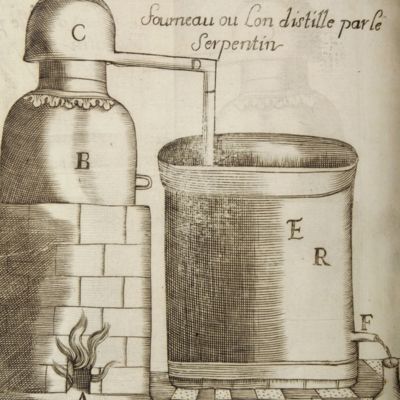Matte La Faveur, S.
Pratique de chymie, divisée en quatre parties, par S. Matte La Faveur, distillateur & demonstrateur ordinaire de la chymie en la faculté de Medecine de Montpelier. Avec un avis sur les eaux minerales.
Montpelier, Daniel Pech, 1671 [1672]. Small 8vo (15.7 x 9.8 cm). [x], 360, 10 (explanatory leaves), [xxxii] pp.; engraved (armorial) frontispiece, 14 engraved plates on 12 large, folded leaves, one being a table of chemical symbols. Contemporary full calf. Spine with five raised bands, rich gilt compartments with floral vignettes and gilt title. Edges mottled red.
"Extremely rare" (Neville) complete copy, with all the plates, of a groundbreaking work on distillation by the self-taught French chemist Sébastien Matte La Faveur (1626-1714). According to Wikipedia, his discovery of styptic water and other important research merited him the position of Demonstrator of Chemistry at the Faculty of Medicine of Montpellier, a position created for him in 1675. He was the inventor of a lavender distillate, "the water of the Queen of Hungary", which became very popular in European courts. Perhaps as a consequence he became the private pharmacist of King Louis XIV and was awarded the privilege of teaching chemistry at the Sorbonne, and at the University of Montpellier. Later he became intendant of the chair of chemistry at the Jardin du Roi (1680 to 1684). This book is his most important work. Daniel Pech was perhaps merely the printer; the title page states that the work was sold by Matte La Faveur. Although the title page is dated 1671, the final print date is stated to be "le premier Fevrier 1672". The explanatory leaves are numbered 1-10, of which 1-2 have been moved to the first folded plate, between pp. 46-47. The first folded leaf contains the first three plates, a fact not noted in some other collations. The frontispiece, which shows a coat-of-arms, should not be counted as a plate. A complete description of the plates and explanatory leaves is as follows: 1. Planche des vaisseaux, with explanatory leaf [pp. 1-2] (between pp. 46-47); 2. Bain Marie (included on the folding Planche des vaisseaux), [explanation on p. 3 after p. 360]; 3. Petit fourneau de reverbere clos (included on the folding Planche des vaisseaux), [explanation p. 3 after p. 360]; 4. Table l'explication des caracteres chymiques (between pp. 58-59; there is no separate explanatory leaf because the explanations are next to the symbols]; 5. Bain vaporeux [placed after explanation p. 4]; 6. Bain sec [between explanation pp. 4-5]; 7. Fourneau ou l'on distille par le serpentin [before explanation on pp. 5-6]; 8. Grand fourneau de reverbere clos [after explanation p. 6]; 9. Fourneau de reverbere decouvert [after explanation p. 6]; 10. Fourneau a vent ou de fonte [before expl. p. 7]; 11. Athenor [before expl. pp. 7-8]; 12. Vaisseau pour faire l'esprit de souffre [between expl. pp. 8-9]; 13. Fourneau de digestion [before expl. p. 9]; 14. Vaisseau pour faire les fleurs de souffre [before expl. pp. 9-10]. "Less than a dozen copies are known to exist, most imperfect with missing leaves and fewer plates" (Neville). Boards rubbed, mainly at the joints. Old inscription "1662" in the lower margin of the title page; a note in old hand "ce livre est rare à montpellier..." on the front pastedown, a very good copy. Neville II, pp. 153-154; Poggendorf II, p. 78; Thorndike VIII, pp. 141-144. Not in Brunet, not in Cat. BM(NH).




